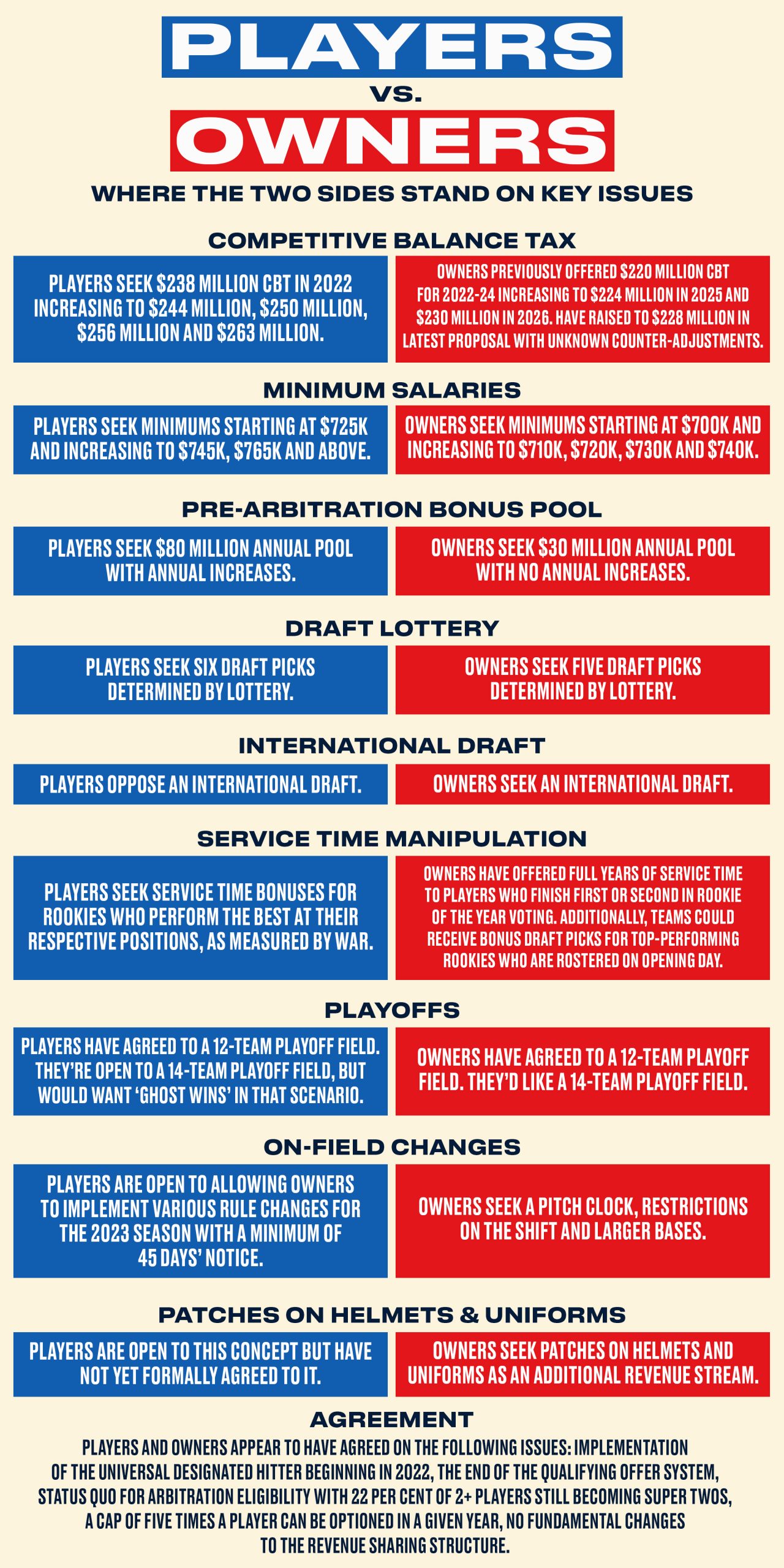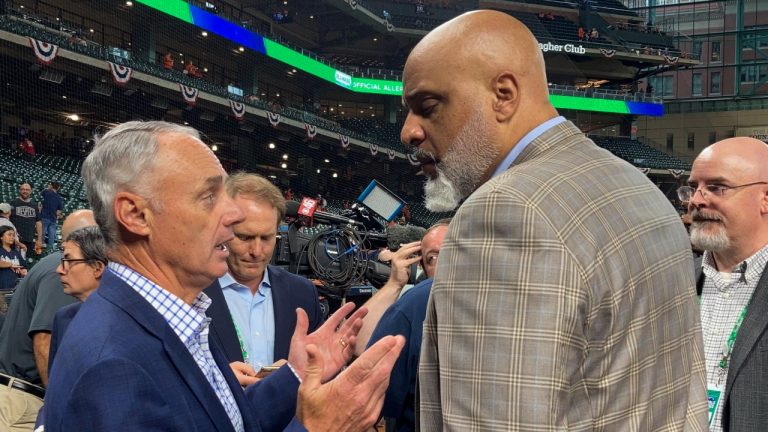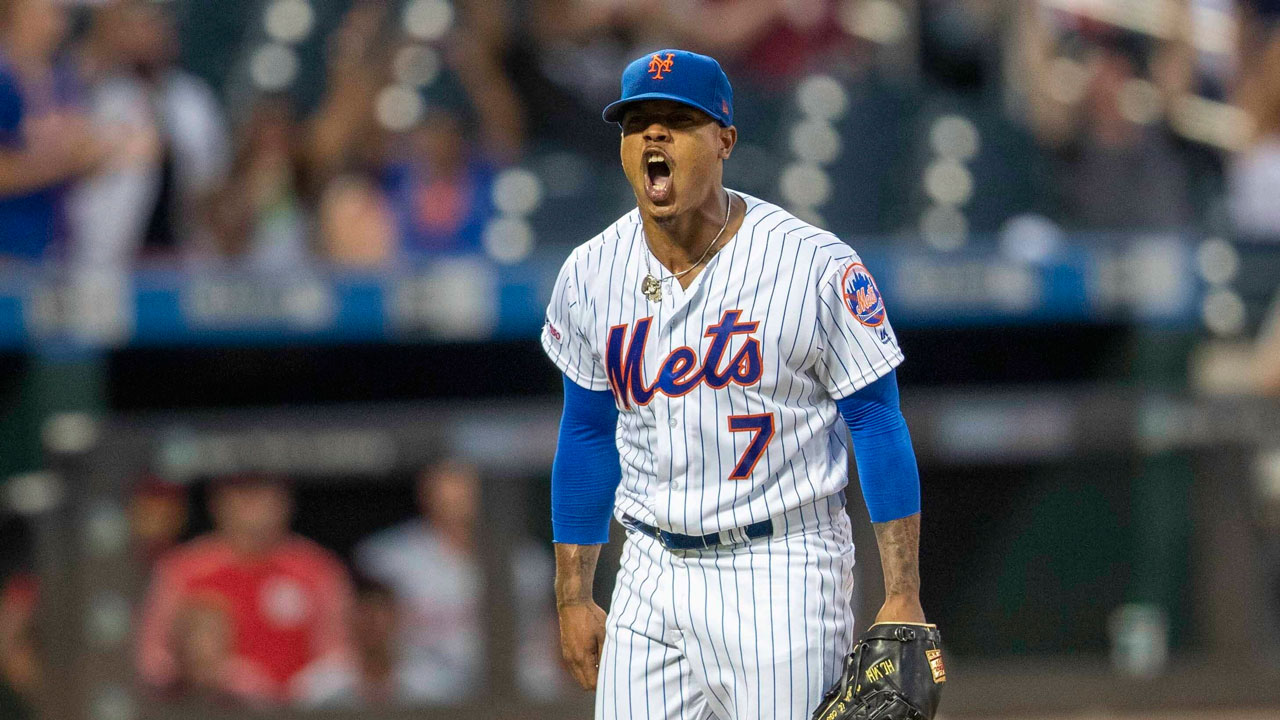TORONTO – For the third time in eight days, MLB has given its players an ultimatum: reach an agreement today or miss regular season games.
The first two times the league took this stance, no deal was reached. And now? A revised offer from the league includes an increase in competitive balance tax, according to Evan Drellich of The Athletic. On the surface it’s an encouraging shift. But if, as Drellich says, the offer came with "major strings attached," the overall changes may have limited appeal to players, who showed last week that they’re willing to miss games if the league doesn’t move on their top issues.
For fans of the game, that’s troubling. And because the league waited six weeks after locking players out before making an initial proposal, there’s no longer time to waste. If the players decline this latest offer, the league will presumably announce the cancellation of another week.
So where have baseball’s owners and players found common ground? Where do the most significant differences exist? And if the current method isn’t working, why not try something else entirely? Let’s attempt to find some answers…
To start: where’s the common ground?
Despite their many differences, owners and players appear to have agreed on some key issues. Among them:
• Implementation of the universal designated hitter beginning in 2022
• The end of the qualifying offer system
• Status quo for arbitration eligibility with 22 per cent of players with between two and three years of service time still becoming super twos (players had initially requested that all players with two-plus years of service time be arbitration eligible)
• Implementation of a cap on the number of times a player can be optioned in a given year (five)
• No seismic changes to the revenue sharing structure
On paper, that’s significant progress. Yet until there's agreement on other aspects of the sport’s core economics, these changes should be considered tentative rather than final.
And the differences?
Of all the issues at stake, multiple sources with knowledge of the discussions describe the competitive balance tax as the most important roadblock.
Yet, as the graphic below shows, considerable distance separates players and owners on core economic questions beyond the CBT.

Why does the CBT matter so much?
In theory, the CBT taxes exorbitant spending. In practice, though, the CBT hasn’t increased in proportion to rising revenues across baseball. As such, it’s started to function as a soft salary cap in the view of many players and agents.
"We look at the competitive balance tax as a breakaway spending mechanism,” union executive subcommittee member Max Scherzer said last week. “That's how this thing was originally negotiated. And when you look at the history of baseball here and our labour, we're not seeing that function as breakaway spending. We're seeing it act as a salary cap."
Reinforcing Scherzer’s point, seven teams avoided the CBT by $8 million or less in 2021: the Red Sox, Astros, Yankees, Padres, Phillies, Angels and Mets. Whatever its original intention, the CBT now disincentivizes spending – a pattern that lowers costs for MLB owners. Players, on the other hand, want something resembling a free market with fewer restrictions on spending.
(While some agents like the idea of a salary floor, there doesn’t appear to be movement on that front in these talks.)
If the CBT is the issue, why not just saw it in middle and get the season started?
If only it were that easy. For the midpoint to be meaningful, all involved would have to believe that the other side was bargaining in good faith. Otherwise, why not make an unrealistic demand to anchor talks in your own favour?
Given that the MLBPA recently accused MLB of trying to break the union, it’s clear there’s not enough trust in place for a saw-it-off-in-the-middle approach to work. Put simply, the players don’t trust that the owners’ starting points are reasonable. And remember: the players have already dropped major demands including earlier free agency and earlier arbitration. They’d argue they’ve already gone halfway and that now it’s time for the owners to move in their direction.
Plus, keep in mind that four owners opposed last week’s offer. According to The Athletic’s Evan Drellich, the Reds, Tigers, Diamondbacks and Angels voted against increasing the CBT threshold as high as $220 million. Since any CBT requires approval from 23 of MLB’s 30 owners, MLB’s negotiating team has work to do behind the scenes each time the league improves its offer. That work is necessary, but it isn’t always easy or quick.
So is there any way around the CBT?
Every last person I’ve heard from believes the CBT to be essential to these talks.
But for the sake of argument, does that have to be the case? In theory, a multi-variable negotiation should allow for flexibility. There’s no rule preventing negotiators from pulling on some different levers to create an outside-the-box solution. As a thought exercise let’s see if there’s a workaround here.
Hypothetically, if MLB offered to increase the MLB minimum salary to $1 million, that could be a concession worth upwards of $100 million annually to the players. That in itself would be a massive game-changer. If the owners were willing to do that while also agreeing to the players’ proposed figures for the pre-arbitration bonus pools, you might have a path to a deal without increasing the CBT much beyond $220 million.
But again, that’s all theoretical. More realistically, there will have to be real movement on the CBT before a deal is reached.
With talks moving so slowly, why not lock everyone in a room until there’s an agreement?
Collective bargaining often develops slowly. It doesn’t have to be this slow, but there are more than a thousand stakeholders here, which creates some practical limitations. The MLBPA consists of roughly 1,200 members, and communicating with players takes some time. Getting 23 of the 30 owners to agree is easier said than done, too. And as we saw in Jupiter, Fla. last week, late-night bargaining sessions and proximity don’t offer any guarantees of a deal.
So while there’s no excuse for the six weeks MLB took to make the players an initial proposal, there’s no way around the reality that each proposal may take a day or two from this point on.
What now?
With each week that passes, more pressure builds for all involved. Owners will soon be missing gate revenue and not long after that they’ll face pressure from their TV partners. Players, meanwhile, are receiving stipends from the MLBPA but they’ll miss their first paychecks in early April.
By now, each side knows what the other side wants. What’s less clear is how long they’re willing to wait to get it.







